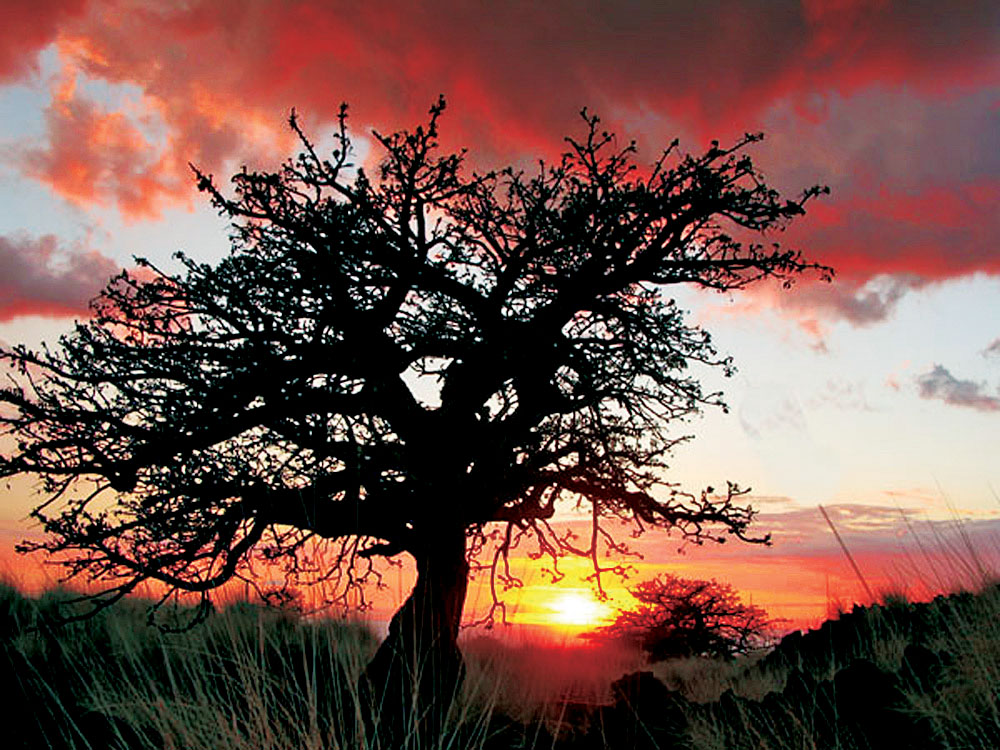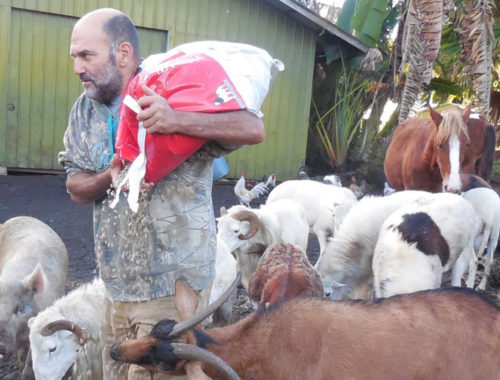
Home on the Ka‘u Range: The Kuahiwi Family Ranch and Natural, Free-Range Beef
 By Denise Laitinen
By Denise Laitinen
When Captain John Vancouver presented King Kamehameha with cattle on the Big Island as a gift in 1793, no one imagined the impact it would have on the future of the island. Kamehameha placed a kapu on the cattle the following year at the suggestion of Vancouver, and the resulting cattle population explosion wreaked havoc on our island’s ecosystem for decades. This, in turn, resulted in the creation of Hawai‘i’s paniolo tradition, with cowboys imported from Mexico to teach locals how to wrangle and manage cattle.
Fast forward nearly 220 years, and it’s surprising to find that many local ranchers make more money shipping their beef off island rather than selling it locally. One ranch in Ka‘ū is working to change that. In fact, the Galimba family has worked very much like the first vacqueros (Mexican cowboys) who came to Hawai‘i, producing free-range, natural beef.
“My father always wanted to have a ranch,” says Michelle Galimba, whose family started Kuahiwi Ranch in 1993. Today they lease 10,000 acres in Ka‘ū between Wood Valley and Wai‘ōhinu, with 2,800 head of cattle grazing on land from sea level to the 2,100-foot elevation. They actually got their start raising dairy cows.
Back in 1993, she said, the timing seemed right and there was a market to raise dairy cows. “My brother was out of school and the sugar plantations were closing, so this land was available,” she explains. Her father, originally from Nā‘ālehu, had spent many years on O‘ahu as a dairyman with Meadow Gold Dairy and he had extensive contacts in the Hawai‘i dairy industry. “My parents, Al and Sami Galimba, and my brother, Guy, started the ranch in 1993. I came back after college (earning a PhD. in comparative literature from UC Berkeley) and joined them.”
“At the time there wasn’t a lot of land for raising dairy cattle on O‘ahu,” says Michelle. “A lot of the dairy farms had housing developments grow up around them, and the cows got more and more confined in feed lots.”
In order to raise calves to become the next generation of dairy cows, many were shipped to Ka‘ū, where they were raised and then shipped back to O‘ahu when they were older.
By 1995, the last remaining dairy farms on O‘ahu closed and the Galimbas switched to raising beef cattle. This switch was not as easy as flipping on a light or changing work clothes. Michelle and her family developed their herd by roping wild cattle. They started with one cow. Like the first vacqueros who came to Hawai‘i to round up wild herds in the 1800s, Michelle says her family “roped wild cattle from abandoned ranches,” she explains.
“It was a lot of work. We did a lot of fencing. We’d spend the week fencing and then one day roping.”
At the time there were a lot of wild cattle in the Ka‘ū district. “There were several ranches that the owners just walked away from,” explains Michelle. “We got the owners’ permission and worked out a deal to rope the cattle [the other ranchers had left behind].”
Roping wild cattle is not for the faint of heart. “I really enjoy it,” says Michelle. She points out that having a horse that likes to chase cows helps too.
“It takes a toll on the horses when you’re roping because the horses have to run really fast,” explains Michelle. She describes how, in the early days of building the ranch’s herd, her horse named Nā‘ālehu had a special knack for finding cows. Ranch dogs would bark if they spotted cows, who typically hid in stands of trees. Michelle says Nā‘ālehu would actually stop and listen for the dogs’ barking and would follow the sound. “I couldn’t hear the dogs barking but she could and would go chase after the cows,” Michelle says with a chuckle.
Over time, the family slowly built up their herd. “We were bringing in 10 to 20 head [of cattle] a week,” explains Michelle. “And that went on for the first five years”.
Michelle admits it was difficult the first few years. She and her mother both held part-time jobs to help make ends meet. “None of us had salaries for the first five years,” she says with a laugh, recalling the early days. “We camped out at my grandmother’s for a few years.”
Not all the cattle at the ranch were caught wild. The Galimbas also traded calves with other ranches. “We would trade the steer calves for girl calves, so that helped us build up our herd faster.”
Maintaining a herd of top quality cattle has always been important to the Galimgas. To that end, they purchased several purebred Angus bulls from Ponoholo Ranch in Kohala to help build up their herd. “They’re known for having top quality Angus bulls,” says Michelle.
Today, the ranch has 2,800 head of cattle, mostly Angus crossbreed, although the family is also raising about 100 head of British White cattle as well.
Choosing to raise beef cattle required some key decisions that would affect the very way they did business.
The family opted to not give their cattle antibiotics or artificial hormones. That left them with two options: natural beef or grass-fed beef. The terms natural beef and grass-fed beef aren’t used lightly. In fact, the U.S. Department of Agriculture (USDA) has strict certification standards for anyone using either label.
As Michelle explains it, “natural beef and grass-fed beef are different but they shade into each other. “Grass-fed beef has to be fed 99 percent grass or forage for the entire life span of the cattle.” If you feed your cattle more than one percent of grain, then you can’t use the title ‘grass-fed’. The term ‘natural beef’ means it is minimally processed and contains no artificial additives.
“Since the weather has been, and can be, very unpredictable here in Ka‘ū, we decided to not go with grass-fed beef because we didn’t want to take the risk of not having enough grass.”
“We wanted to have a consistent beef product for high-end restaurants like Alan Wong’s, so we decided to raise natural beef.”
These days Kuahiwi Ranch is actively building their herd based on breeds of cattle that prefer being grass fed. “Some cows are actually bred to be in a feed-lot environment,” explains Michelle. “My mom [Sami] started looking at cattle breeds that were particularly suited to being raised free range.” Michelle says it was her mother that first had the idea of importing British White cattle about six years ago. The British White cattle are smaller in size and thrive in a grass-fed environment.
“They’re a really ancient breed,” says Michelle. Indeed, traces of the British White breed can be traced back to the 1500s in Europe. The cattle were such an important part of British cattle culture that a certain amount of cattle were airlifted out of Britain during World War II and relocated to the U.S. That makes them unique, but it was their eyes that sealed the deal.
“Here in Hawai‘i we have a tropical climate with a lot of sunshine. British White have black pigmentation around their eyes,” explains Michelle. “Other breeds of cattle that do well being grass fed have white pigmentation around their eyes, which makes them susceptible to skin cancer.”
In 2006, Kuahiwi Ranch bought 14 British White cattle from a ranch in San Luis Obispo, California. “They were very expensive and shipping them here was expensive,” says Michelle. They did well and now they have about 100 head of the heritage breed.
“The British White cattle, like the rest of our cattle, are free range,” says Michelle. They are out in grass pastures their whole lives.” In fact, if you look mauka while driving from Punalu’u Beach to Wai‘ōhinu along Highway 11, you might see their cattle roaming the land.
Weather in Ka‘ū has lately affected the grass supply, so the cattle’s diet is supplemented with all-natural wheat, barley, corn and molasses.
Over the past few years, drought and vog have plagued Ka‘ū. Michelle says the vog hasn’t really been an issue, but all of their pastures have been affected by the drought. For ranchers, it’s never economically feasible to haul in water. “Bringing water in is cost prohibitive and with the amount of land you need to irrigate—Kuahiwi leases 10,000 acres—you would bankrupt yourself very, very quickly, especially in Ka‘ū,” explains Michelle.
They are dealing with the devastating effects of the drought just when the interest in, and market for, locally grown beef is soaring.
“There is so much more demand than we can fill right now,” says Michelle of the local beef market. “Not just on this island, but on O‘ahu too.”
Michelle explains that, until a few years ago, island ranchers were sending the majority of their beef off island while at the same time local chefs were buying beef from the mainland.
Cattle are sold and then shipped to the mainland by barge or airplane because it is cheaper to send them off island (even by plane) than it is to pay for shipping grain to Hawai‘i to feed the cattle.
In recent years, chefs like Alan Wong and Roy Yamaguchi, pioneers of Hawai‘i Regional Cuisine, have started touting the benefits of Hawai‘i-grown beef. Michelle recalled how Alan Wong set up a presentation about four years ago in which he invited chefs on O‘ahu to sample locally grown food, including Kuahiwi Ranch beef. “They [the chefs] had no idea they could get local beef,” says Michelle.
“Until we started selling beef to local markets about three years ago I assumed they had access to it and they really didn’t,” explains Michelle. “The market is exploding.”
Interestingly enough, their beef is found in more places on O‘ahu than Hawai‘i Island. It was a strategic choice the family made. “There were already other people supplying local markets,” explains Michelle. “Instead of competing with them, we explored the other islands.”
Their beef is featured at several restaurants on O‘ahu, including Alan Wong’s Pineapple Room and King Street locations, as well as d.k. Steakhouse. On Hawai‘i Island it can be found at Sansei in Waikoloa, and in Volcano at ‘Ohia Café and Kīlauea Lodge. Foodland Supermarkets recently started selling their beef statewide. They are also at the Nā‘ālehu, Volcano, Ocean View and Kino‘ole St. farmers markets.
“We really want to expand what we can provide to the local market,” says Michelle. “We provide Foodland with fresh beef every week. They want more beef than we can provide.”
Which brings us back to grass. With the drought conditions, the fact that the ranch must still adhere to USDA standards for natural beef and their own high standards of producing top quality beef for high-end restaurants, the ranch is currently sending a little more than half their cattle to the Mainland to be fattened up. Michelle says that they could keep more beef on island if there were more grass for the cattle to eat.
“If it rains a lot, we get to keep the cattle back, because there is more grass for them to feed,” she explains. Even with drought conditions the past few years, they have increased the amount of cattle they are able to sell locally. “Every year we are keeping more and more beef—about 10-15 percent more every year—here on island.”
Yet Michelle points out that the ranch is more than just producing beef. “It’s about taking care of the land and using the land,” she says. “The way I see it we have an ecosystem here. The land, the people, the community around us.”
These days the land and the people of Ka‘ū could use a little more rain. ❖
Contact writer Denise Laitinen: wahineokekai@yahoo.com
All photos courtesy of Kuahiwi Ranch
For more info: kuahiwiranch.com


